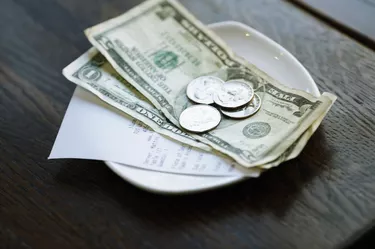
Standard tips on food have traditionally been 15 percent for good service, while 10 percent covered a bar tab. To make things more complicated, you weren't expected to tip on sales tax. Different industries, such as the taxi business, hotel housekeepers or the delivery service industry, had their own tipping standards.
In recent years, more and more restaurants have been suggesting 20 percent tips, while diners have also been tipping this amount for excellent (not just standard) service or because it's mathematically easier to calculate. Knowing how to quickly calculate a 20 percent tip is easy using a simple, two-step math trick.
Video of the Day
Video of the Day
What’s the Point of Tipping?
Tipping originally started in Europe, where tips were paid at the beginning of a meal. Urban legends hold that the word "tip" was an acronym that stood for To Insure Promptness, explains Las Vegas Advisor. This is not true, but diners did tip in advance many years ago to get special service from busy food servers or bartenders.
When tipping came to America, it eventually became a club held over a server's head, paid after the server provided good service. It also helps ensure that if you are a regular, the servers treat you well when you come in.
Another reason we tip when service isn't that special is that many servers do not receive even a minimum wage hourly pay, nor do they receive benefits like health insurance or retirement contributions. They make their living based on their tips. While an extra dollar might not seem like much to you, multiplied by 30 customers a night, that's an extra $30 per shift on top of the server's base pay.
How Should You Tip?
If your server is rude, gets your order wrong or doesn't bother to visit your table the entire time you're eating to see if you need anything, should you leave a 15 percent tip, which is the same as what good servers get? If you're a regular, you probably should, unless you want that server to add a surprise to your food or drink next time you come in. You can anonymously blast her on Yelp or another restaurant review site to avoid an awkward reunion the next time you come in.
Sometimes a server has a reason (not an excuse) for giving poor service. One or more servers might have called in sick and the server is overwhelmed. The server might be a trainee and wasn't given proper instruction. If that's the case, you might want to give him a break and tip the full 15 percent.
If your server is rude, arrogant, slow and downright unprofessional, there's something worse you can do than leave no tip – you can leave a penny on the table. This tells the server you're not cheap or you forgot to tip, you're letting the server know you thought he was lousy.
How to Quickly Calculate a 20 Percent Tip
The simplest, quickest way to tip 20 percent is to multiply your total bill by 10 percent, then multiply by two. If your bill was $10.80, 10 percent is $1.08. Multiplied by two, your tip is $2.16. Your total cost is now $12.96 – feel free to round it up to $13.
If you want to be technically correct, you could tip on the pre-tax amount, but so few people know to do this, you might offend the server or look cheap in front of your friends. CNBC points out, however, that pre-tax tipping can add up to significant savings for you over the course of a year. On a larger bill, a tip on the pre-tax amount still leaves enough money in your server's pocket that she'll probably understand that you're a savvy diner.
Beware of European Friends
If you're dining with friends from Europe and take them to one of your favorite restaurants, keep an eye on them if they offer to pick up the tab. In many European countries, the tip is added to the bill as a table charge. Therefore, when a European gets a food bill, she might pay the amount on the bill, or (quite often), simply round up to the next dollar, leaving an extra few cents.
If you don't pay attention when you're with your friend, she might stiff your favorite waiter or, worse yet, leave a 30 cent tip.